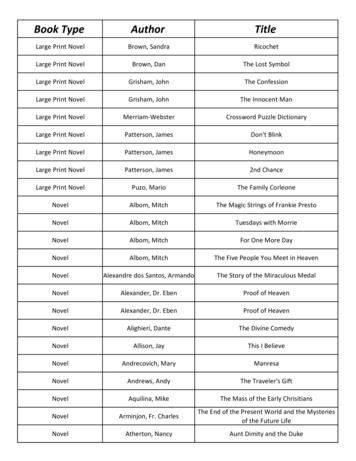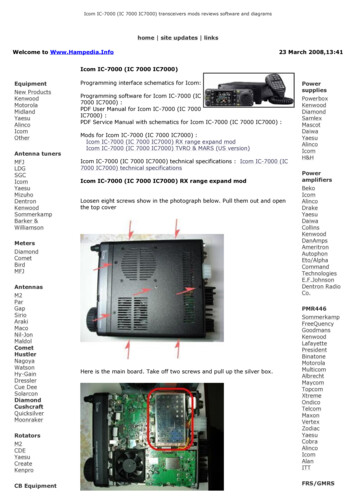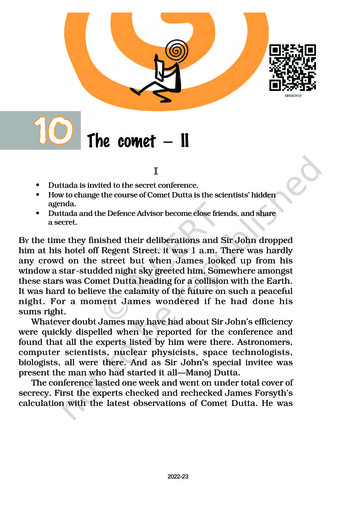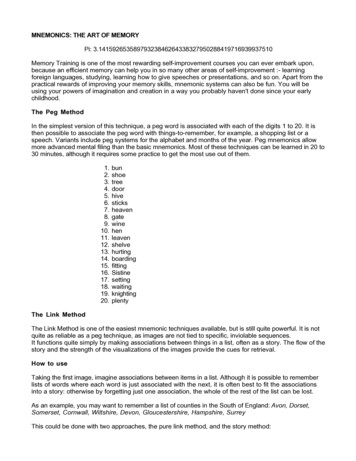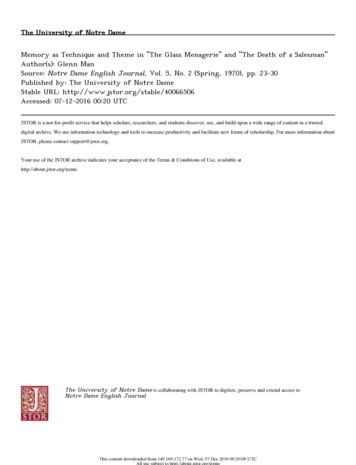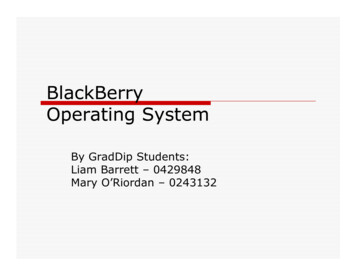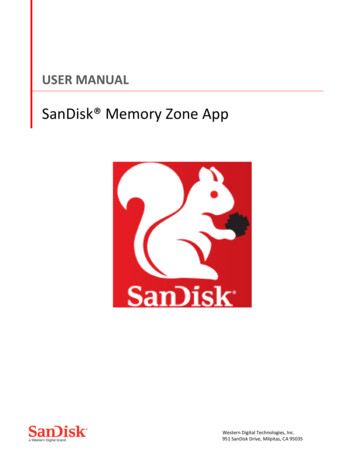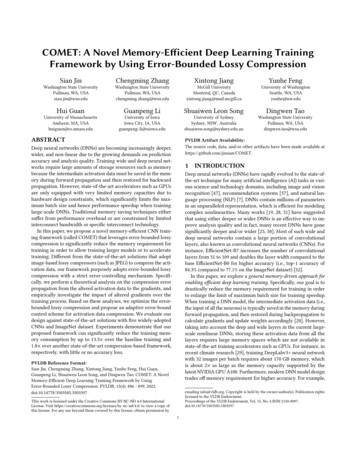
Transcription
COMET: A Novel Memory-Efficient Deep Learning TrainingFramework by Using Error-Bounded Lossy CompressionSian JinChengming ZhangXintong JiangYunhe FengWashington State UniversityPullman, WA, USAsian.jin@wsu.eduWashington State UniversityPullman, WA, USAchengming.zhang@wsu.eduMcGill UniversityMontréal, QC, Canadaxintong.jiang@mail.mcgill.caUniversity of WashingtonSeattle, WA, USAyunhe@uw.eduHui GuanGuanpeng LiShuaiwen Leon SongDingwen TaoUniversity of MassachusettsAmherst, MA, USAhuiguan@cs.umass.eduUniversity of IowaIowa City, IA, USAguanpeng-li@uiowa.eduUniversity of SydneySydney, NSW, Australiashuaiwen.song@sydney.edu.auWashington State UniversityPullman, WA, USAdingwen.tao@wsu.eduABSTRACTPVLDB Artifact Availability:The source code, data, and/or other artifacts have been made available athttps://github.com/jinsian/COMET.Deep neural networks (DNNs) are becoming increasingly deeper,wider, and non-linear due to the growing demands on predictionaccuracy and analysis quality. Training wide and deep neural networks require large amounts of storage resources such as memorybecause the intermediate activation data must be saved in the memory during forward propagation and then restored for backwardpropagation. However, state-of-the-art accelerators such as GPUsare only equipped with very limited memory capacities due tohardware design constraints, which significantly limits the maximum batch size and hence performance speedup when traininglarge-scale DNNs. Traditional memory saving techniques eithersuffer from performance overhead or are constrained by limitedinterconnect bandwidth or specific interconnect technology.In this paper, we propose a novel memory-efficient CNN training framework (called COMET) that leverages error-bounded lossycompression to significantly reduce the memory requirement fortraining in order to allow training larger models or to acceleratetraining. Different from the state-of-the-art solutions that adoptimage-based lossy compressors (such as JPEG) to compress the activation data, our framework purposely adopts error-bounded lossycompression with a strict error-controlling mechanism. Specifically, we perform a theoretical analysis on the compression errorpropagation from the altered activation data to the gradients, andempirically investigate the impact of altered gradients over thetraining process. Based on these analyses, we optimize the errorbounded lossy compression and propose an adaptive error-boundcontrol scheme for activation data compression. We evaluate ourdesign against state-of-the-art solutions with five widely-adoptedCNNs and ImageNet dataset. Experiments demonstrate that ourproposed framework can significantly reduce the training memory consumption by up to 13.5 over the baseline training and1.8 over another state-of-the-art compression-based framework,respectively, with little or no accuracy loss.1INTRODUCTIONDeep neural networks (DNNs) have rapidly evolved to the state-ofthe-art technique for many artificial intelligence (AI) tasks in various science and technology domains, including image and visionrecognition [47], recommendation systems [57], and natural language processing (NLP) [7]. DNNs contain millions of parametersin an unparalleled representation, which is efficient for modelingcomplex nonlinearities. Many works [19, 28, 51] have suggestedthat using either deeper or wider DNNs is an effective way to improve analysis quality and in fact, many recent DNNs have gonesignificantly deeper and/or wider [25, 58]. Most of such wide anddeep neural networks contain a large portion of convolutionallayers, also known as convolutional neural networks (CNNs). Forinstance, EfficientNet-B7 increases the number of convolutionallayers from 31 to 109 and doubles the layer width compared to thebase EfficientNet-B0 for higher accuracy (i.e., top-1 accuracy of84.3% compared to 77.1% on the ImageNet dataset) [52].In this paper, we explore a general memory-driven approach forenabling efficient deep learning training. Specifically, our goal is todrastically reduce the memory requirement for training in orderto enlarge the limit of maximum batch size for training speedup.When training a DNN model, the intermediate activation data (i.e.,the input of all the neurons) is typically saved in the memory duringforward propagation, and then restored during backpropagation tocalculate gradients and update weights accordingly [20]. However,taking into account the deep and wide layers in the current largescale nonlinear DNNs, storing these activation data from all thelayers requires large memory spaces which are not available instate-of-the-art training accelerators such as GPUs. For instance, inrecent climate research [29], training DeepLabv3 neural networkwith 32 images per batch requires about 170 GB memory, whichis about 2 as large as the memory capacity supported by thelatest NVIDIA GPU A100. Furthermore, modern DNN model designtrades off memory requirement for higher accuracy. For example,PVLDB Reference Format:Sian Jin, Chengming Zhang, Xintong Jiang, Yunhe Feng, Hui Guan,Guanpeng Li, Shuaiwen Leon Song, and Dingwen Tao. COMET: A NovelMemory-Efficient Deep Learning Training Framework by UsingError-Bounded Lossy Compression. PVLDB, 15(4): 886 - 899, 2022.doi:10.14778/3503585.3503597emailing info@vldb.org. Copyright is held by the owner/author(s). Publication rightslicensed to the VLDB Endowment.Proceedings of the VLDB Endowment, Vol. 15, No. 4 ISSN 2150-8097.doi:10.14778/3503585.3503597This work is licensed under the Creative Commons BY-NC-ND 4.0 InternationalLicense. Visit https://creativecommons.org/licenses/by-nc-nd/4.0/ to view a copy ofthis license. For any use beyond those covered by this license, obtain permission by1
Gpipe [21] increases the memory requirement by more than 4 forachieving a top-1 accuracy improvement of 5% from Inception-V4.Evolving in recent years, on the one hand, model-parallel [3]techniques that distribute the model into multiple nodes can reduce the memory consumption of each node but introduce highcommunication overheads; on the other hand, data-parallel techniques [45] replicate the model in every node but distribute thetraining data to different nodes, thereby suffering from high memory consumption to fully utilize the computational power. Severaltechniques such as recomputation, migration, and lossless compression of activation data have been proposed to address the memoryconsumption challenge for training large-to-large-scale DNNs. Forexample, GeePS [8] and vDNN [42] have developed data migration techniques for transferring the intermediate data from GPU toCPU to alleviate the memory burden. However, the performanceof data migration approaches is limited by the specific intra-nodeinterconnect technology (e.g., PCIe and NVLinks [14]) and its available bandwidth. Some other approaches are proposed to recomputethe activation data [5, 15], but they often incur large performancedegradation, especially for computationally intensive layers such asconvolutional layers. Moreover, memory compression approachesbased on lossless compression of activation data [49] suffer from thelimited compression ratio (e.g., only around 2:1 for most floatingpoint data). Alternatively, recent works [6, 13] proposed to developcompression offloading accelerators for reducing the activationdata size before transferring it to the CPU DRAM. However, addinga new dedicated hardware component to the existing GPU architecture requires tremendous industry efforts and is not ready forimmediate deployment. This design may not be general enough toaccommodate future DNN models and accelerator architectures.To tackle these challenges, we propose a memory-efficient deepneural network training framework (called COMET, lossy Compression Optimized Memory-Efficient Training) by compressing theactivation data using adaptive error-bounded lossy compression.Compared to lossy compression approaches such as JPEG [56] andJPEG2000 [54], error-bounded lossy compression can provide morestrict control over the errors that occurred to the floating-pointactivation data. Also, compared to lossless compression such asGZIP [9] and Zstd [62], it can offer a much higher compression ratioto gain higher memory consumption reduction and performanceimprovement. The key insights explored in this work include: (i)the impact of compression errors that occurred in the activationdata on the gradients and the entire CNN training process underthe strict error-controlling lossy compression can be theoreticallyand experimentally analyzed, and (ii) the validation accuracy canbe well maintained based on an adaptive fine-grained control overerror-bounded lossy compression (i.e., compression error). To thebest of our knowledge, this is the first work to investigate the lossycompression error impact during CNN training and leverage thisanalysis to significantly reduce the memory consumption for traininglarge CNNs while maintaining high validation accuracy. In summary,this paper makes the following contributions: We propose a novel memory-efficient CNN training frameworkvia dynamically compressing the intermediate activation datathrough error-bounded lossy compression.Figure 1: An example data flow of one iteration in CNN training with our COMET framework. We provide a thorough analysis of the impact of compressionerror propagation during DNN training from both theoreticaland empirical perspectives. We propose an adaptive scheme to adaptively configure theerror-bounded lossy compression based on a series of currenttraining status data. We propose an improved SZ error-bounded lossy compressionto further handle compressing continuous zeros in the intermediate activation data, which can avoid the significant alteration(vanish or explosion) of gradients. We evaluate our proposed training framework on four widelyadopted DNN models (AlexNet, VGG-16, ResNet-18, ResNet-50)with the ImageNet-2012 dataset and compare it against stateof-the-art solutions. Experimental results show that our designcan reduce the memory consumption by up to 13.5 and 1.8 compared to the original training framework and the state-ofthe-art method, respectively, under the same batch size. COMETcan improve the end-to-end training performance by leveragingthe saved memory for some models (e.g., about 2 trainingperformance improvement on AlexNet).The rest of this paper is organized as follows. In Section 2, wediscuss the background and motivation of our research. In Section 3,we describe an overview of our proposed COMET framework. InSection 4, we present our theoretical support of error impact onvalidation accuracy from compressed activation data during training. In Section 5, we present the evaluation results of our proposedCOMET from the perspectives of parameter selection, memoryreduction ability, and performance. In Section 6, we conclude ourwork and discuss our future work.2BACKGROUND AND MOTIVATIONIn this section, we first present the background information on largescale DNN training (i.e., some related work on memory reductiontechniques for training) and error-bounded lossy compression forfloating-point data. We then discuss the motivation of this workand our research challenges.2.1Training Large-Scale DNNsTraining deep and wide neural networks has become increasinglychallenging. While many state-of-the-art deep learning frameworks
Figure 2: Memory consumption and top-1 accuracy of different state-of-the-art neural networks (batch size 128).such as TensorFlow [1] and PyTorch [40] can provide high training throughput by leveraging the massive parallelism on generalpurpose accelerators such as GPUs, one of the most common bottlenecks remains to be the high memory consumption during thetraining process, especially considering the limited on-chip memoryavailable on modern DNN accelerators. This is mainly due to theever-increasing size of the activation data computed in the trainingprocess. Training a neural network involves many training epochsto update and learn the model weights. Each iteration includes aforward and backward propagation, as shown in Figure 1. The intermediate activation data (the output from each neuron) generated byevery layer are commonly kept in the memory until the backpropagation reaches this layer again. Several works [5, 8, 13, 15, 42] havepointed out the large gap between the time when the activationdata is generated in the forward propagation and the time when theactivation data is reused in the backpropagation, especially whentraining very deep neural networks.Figure 2 shows the memory consumption of various neural networks. For these CNNs, comparing with the model/weight size, thesize of activation data is much larger since the convolution kernelsare relatively small compared to the activation tensors. In addition,training models with enormous batch size over multiple nodes cansignificantly reduce the training time [16, 41, 61] while reducingthe memory consumption can enlarge the maximum batch sizecapability of a single node for an overall lower cost. In summary,we are facing two main challenges due to the high memory consumption in today’s deep learning training: (1) it is challenging toscale up the training process under a limited GPU memory capacity,and (2) a limited batch size leads to low training performance.In recent years, several works have been proposed to reduce thememory consumption for DNN training, including activation datarecomputation [5, 15], migration [8, 42], and compression [13]. Recomputation takes advantage of the layers with low computationalcost, such as the pooling layer. Specifically, it frees those layers’activation data and recomputes them based on their prior layersduring the backpropagation on demand. This method can reduceunnecessary memory costs, but it is only applicable for the layersof limited types to achieve low performance overhead. For example, compute-intensive convolutional layers that are often hard torecomputed dwarf the efforts of such a method.Another type of methods are proposed around data migration[8, 42], which sends the activation data from the accelerator to theCPU host when generated, and then loads it back from the hostwhen needed. However, the performance of data migration heavilydepends on the interconnect bandwidth available between the hostand the accelerator(s), and the intra-node interconnect technologyapplied. For example, NVLink [14] technology is currently limitedto high-end NVIDIA AI nodes (e.g., DGX series) and IBM powerseries. This paper targets to develop a general technique that canbe applied to all types of HPC and datacenter systems.Finally, data compression is another efficient approach to reducememory consumption, especially for conserving the memory bandwidth [12, 13, 30]. The basic idea using data compression here is tocompress the activation data when generated, hold the compresseddata in the memory, and decompress it when needed. However,using lossless compression [6] can only provide a relatively lowmemory reduction ratio (i.e., compression ratio), e.g., typically lowerthan 2 . Some other studies such as JPEG-ACT [13] leverages thesimilarity between activation tensors and images for vision recognition tasks and apply a modified JPEG lossy compressor to activationdata. But it suffers from two main drawbacks: First, it introducesuncontrollable compression errors to activation data. Eventually,it could lose control of the overall training accuracy since JPEG ismainly designed for images and is an integer-based lossy compression. Second, the JPEG-based solution [13] needs support from adedicated hardware component to be added to GPU hardware, andit cannot be directly deployed to today’s systems.We note that all three methods above are orthogonal to eachother, which means they could be deployed together to maximizethe memory reduction and training performance. Thus, in this paper, we mainly focus on designing an efficient data compression,more specifically a lossy-compression-based solution, to achievethe memory reduction ratio beyond the state-of-the-art approachon CNN models. In addition, since convolutional layers are themost difficult type of layers for efficient recomputation, our solution focuses on convolutional layers to provide high compressionratios with minimum performance overheads and accuracy losses.We also note that COMET can further improve the training performance by combining with model parallelism techniques suchas Cerebro [39], which is designed for efficiently training multiplemodel configurations to select the best model configuration.2.2Lossy Compression for Floating-Point DataFloating-point data compression has been studied for decades. Lossycompression can compress data with little information loss in thereconstructed data. Compared to lossless compression, lossy compression can provide a much higher compression ratio while stillmaintaining useful information for scientific or visualized discoveries. Lossy compressors offer different compression modes to control compression error or compression ratio, such as error-boundedmode. The error-bounded mode requires users to set an error bound,such as absolute error bound and point-wise relative error bound.The compressor ensures that the differences between the originaland reconstructed data do not exceed the user-set error bound.In recent years, a new generation of lossy compressors for scientific data have been proposed and developed, such as SZ [10, 32, 53]and ZFP [34]. Unlike traditional lossy compressors such as JPEG[56] which are designed for images (in integers), SZ and ZFP aredesigned to compress floating-point data and can provide a stricterror-controlling scheme based on user’s requirements. In this work,
we choose SZ instead of ZFP because the GPU version of SZ—cuSZ [55] 1 —provides a higher compression ratio than ZFP andoffers the absolute error bound mode that the GPU version of ZFPdoes not support (but necessary for our error control). Specifically,SZ is a prediction-based error-bounded lossy compressor for scientific data. SZ has three main steps: (1) predict each data point’svalue based on its neighboring points by using an adaptive, best-fitprediction method; (2) quantize the difference between the realvalue and predicted value based on the user-set error bound; and(3) apply a customized Huffman coding and lossless compressionto achieve a higher ratio. We note that a recent work [25] proposedto use the new generation of lossy compressors to compress DNNweights, thereby significantly reducing model storage overhead andtransmission time. However, this work only focuses on compressingthe DNN model itself instead of compressing the activation data toreduce memory consumption.2.3Research Goals and ChallengesThis is the first known work that explores whether the new generation of lossy compression techniques, which have been widelyadopted to help scientific applications gain significant compressionratio with precise error control, can significantly reduce the highmemory consumption of the common gradient-descent-based training scenarios (e.g., CNNs with forward and backward propagation).We focus on compressing the activation data of convolutional layers,because (1) convolutional layers dominate the size of activation dataand cannot be easily recomputed [58], and (2) non-convolutionallayers (e.g., pool layers or fully-connected layers) can be easilyrecomputed for memory reduction due to their low computationcomplexity.Note that convolutional layers also dominate the computationaltime during training process, which benefits us for apply compression with low overhead. Similar to many previous studies[13, 24, 42, 58], our research goal is to develop an efficient andgeneric strategy to achieve a high reduction in memory consumption for CNN training. Our work can increase the batch size limitand convergence speed or enable training on the hardware withlower memory capacity for the same CNN model.To achieve this goal, there are several critical challenges to beaddressed. First, because of the prediction-based mechanism of SZlossy compressor, when compressing continuous zeros in betweenthe data, SZ cannot guarantee the decompressed array to remainthe same continuous zeros but decompress them into a continuousvalue that is within the user-defined error bound to zero. This characteristic can cause non-negligible side-effects when implementingour proposed COMET. Thus, we must propose a modified versionof SZ lossy compression to overcome this issue for our use case.Second, since we plan to use an error-bounded lossy compressor, astrictly controlled compression error would be introduced to theactivation data. In order to maintain the training accuracy curvewith a minimum impact to the performance and final model accuracy, we must understand how the introduced error would propagatethrough the whole training process. In other words, we must theoretically and/or experimentally analyze the error propagation, which is1 Compared to CPU SZ, cuSZ can provide much higher compression and decompressionspeed on GPUs and can also be tuned to avoid the CPU-GPU data transfer overheads.challenging. To the best of our knowledge, there is no prior investigation on this. Third, once we understand the connection betweenthe controlled error and training accuracy, how to balance the compression ratio and accuracy degradation in a fine granularity isalso challenging. In other words, a more aggressive compressioncan provide a higher compression ratio but also introduces moreerrors to activation data, which may significantly degrade the finalmodel accuracy or training performance (cannot converge). Thus,we must find a balance to offer as high a compression ratio as possible to different layers across different iterations while maintainingminimal impact to the accuracy.3DESIGN METHODOLOGYIn this section, we describe the overall design of our proposedlossy compression supported CNN training framework COMETand analyze the performance overhead.Our proposed memory-efficient framework COMET is shown inFigure 3. We iteratively repeat the process shown in the figure foreach convolutional layer in every iteration. COMET mainly includesfour phases, shown in Figure 3 from left to right: (1) parametercollection of current training status for adaptive compression, (2)gradient assessment to determine the maximum acceptable gradienterror, (3) estimation of compression configuration (e.g, absoluteerror bound), and (4) compression/decompression of activationdata with our modified cuSZ. Note that the analysis of our errorbound control scheme for lossy compression of activation data thatsupports the COMET design will be presented in Section 4.3.1Parameter CollectionFirst, we collect the parameters of the current training status for thefollowing adjustment of lossy compression configurations. COMETmainly collects two types of parameters: (1) offline parametersin CNN architecture, and (2) semi-online parameters includingactivation data samples, gradient, and momentum.First of all, we collect multiple static parameters including batchsize, activation data size of each convolutional layer, and the size ofits output layer. We need these parameters because they affect thenumber of elements considered into each value in the gradient andhence affect the standard deviation 𝜎 in its normal error distribution,which will further impact the validation accuracy curve duringtraining if introduced excessive error too. It would also help theframework collects corresponding semi-online parameters.For the semi-online parameters, we collect the sparsity of activation data and its average gradient of the loss in backpropagationto estimate how the compression error would propagate from theactivation data to the gradient. For the gradient, we compute theaverage value of its momentum. Note that in many DNN trainingframeworks such as Caffe [23] and TensorFlow [1], momentumis naturally supported and activated, so it can be easily accessed.The data collection phase is shown as the dashed thin arrows inFigure 3.Moreover, an active factor 𝑊 needs to be set at the beginningof training process to adjust the overall activeness in COMET. 𝑊is used to determine the activeness of our parameter extraction.We only extract semi-online parameters every 𝑊 iterations to reduce the computation overhead and improve the overall training
Figure 3: Overview of our proposed memory-efficient CNN training framework COMET.performance. Based on our experiment, these parameters vary relatively slowly during training (i.e., the model would not changedramatically with reasonable learning rates in a short time). Thus,we only need to estimate the error impact in a fixed iteration interval in COMET. In this paper, we set 𝑊 to 1000 as default, whichprovides high accuracy and low overhead in our evaluation. However, COMET would reduce 𝑊 by half if it determines that themaximum error-bound change of all layers between 𝑊 exceeds 2 ,and reset 𝑊 to default when the error-bound settles to reduce theoptimization time. We note that this technique is only effective formodels that evolve rapidly during training. Also, note that we stilluse decompressed data during training to collect these parameters,and the collected parameters from one period of iterations onlyaffect during the following optimization computation.3.2Gradient AssessmentNext, we estimate the limit of the gradient error that would resultin little or no accuracy loss to the validation accuracy curve duringtraining, as shown in Figure 3. Even with the help of the offset frommomentum, we still want to keep the gradient of each iteration asclose as possible to the original one. Based on our analysis (will bediscussed in Section 4.3), we need to determine the acceptable standard deviation 𝜎 in the gradient error distribution that minimizesthe impact on the overall validation accuracy curve during training.We use 1% as the acceptable error rate based on our empirical study(will be shown in Section 5.2), i.e., the 𝜎 in the momentum errormodel needs to be:𝜎 0.01𝑀𝐴𝑣𝑒𝑟𝑎𝑔𝑒 ,(1)where 𝑀𝐴𝑣𝑒𝑟𝑎𝑔𝑒 is the average value of the momentum. Note thathere we use the average value instead of the modulus length ofthe momentum because we focus on each individual value of thegradient and the average value is more representative. The averagevalue of the momentum can be considered as the average valueof the gradient over a short time period based on the followingequation:𝑀𝑡 𝛼𝐺𝑡 1 𝛽𝐺𝑡 ,(2)where 𝑀𝑡 is the momentum and 𝐺𝑡 is the gradient at iteration 𝑡.We monitor the momentum by using the API provided by trainingframework (e.g., MomentumOptimizer in TensorFlow) and calculate its average value using simple matrix operations. Similarly,based on our experiment, the average value of gradient does nottend to vary dramatically in a short time period during training.3.3Activation AssessmentAfter that, we dynamically configure the lossy compression foractivation data based on the gradient assessment in the previousphase and the collected parameters as shown in Figure 3. Basedon our analysis (to be performed in Section 4.2), we need 𝜎 (fromgradient error model), 𝑅 (sparsity of activation data), 𝐿 (averagevalue of current loss), and 𝑁 (batch size) to determine the acceptableerror bound for compressing the activation data at the current layerin order to satisfy the gradient error limit proposed in the previousphase. We simplify our estimator as below:𝜎(3)𝑒𝑏 ,𝑎𝐿 𝑁 𝑅where 𝑒𝑏 is the absolute error bound for activation data with SZlossy compressor, 𝜎 describes the acceptable error distribution inthe gradient, 𝑎 is the empirical coefficient, 𝐿 is the average value ofthe current layer’s loss, 𝑁 is the batch size, and 𝑅 is the sparsity ratioof activation data. Note that our technique can be applied to anynon-momentum-based training, which only needs to monitor the“hidden” momentum which can be derived by gradient via simplematrix operations.3.4Optimized Adaptive CompressionIn the last phase, we deploy the lossy compression with our optimized configuration to the corresponding convolutional layers.We also monitor the compression ratio for analysis. Note that wecompress the activation data of each convolutional layer right afterits forward pass. We then decompress the compressed activationdata in the backpropagation when needed. Also, we only performthe adaptive analysis in every 𝑊 iterations from Section 3.1 tominimize the analysis overhead. For Pooling, Normalization, andActivation layers, we use the recomputation technique to reducetheir memory consumption since they take a large proportion ofthe memory consumption ( 60% in the four tested models) withlittle recomputation overhead. The other layers do not consume anoticeable amount of memory, so they are processed as is.At the beginning of each training, the training dataset is unknown, and there is no collected semi-online parameter. COMETtrains the model with original batch size to guarantee the memoryconstraint for the first 𝑊 iterations (negligible to the entire trainingprocess) to collect parameters. After that, COMET starts to dynamically adjust the batch size based on the previous compressionratio and control the remaining memory space under the following optimizations: (1) choosing the batch size of 2𝑘 to stabilize the
performance, where 𝑘 0 is an integer; (2) defining a maximumbatch size to avoid unnecessary scaling for smaller models; and (3)reserving 5% of the total available GPU memory when calculatingthe capable batch size to avoid overflow caused by unexpectedlylow compression ratio. For the extremely low compression ratiocase, the compressed data will be evacuated to CPU with a certaincommunication overhead. However, in our evaluation, this rarelyhappens with the 5% reserved memory space and thus results in anegligible overhead to the system. We also note that the optimizedbatch size is almost const
Gpipe [21] increases the memory requirement by more than 4 for achieving a top-1 accuracy improvement of 5% from Inception-V4. Evolving in recent years, on the one hand, model-parallel [3] techniques that distribute the model into multiple nodes can re-duce the me
